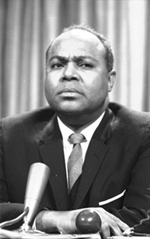Introduction
 © 2008 Matthew Yglesias from Washington,
© 2008 Matthew Yglesias from Washington, United States
 © 2006 Quinn Dombrowski
© 2006 Quinn DombrowskiIn this lesson, you will learn how to give an effective formal presentation, a skill you need to succeed in your classes and probably in your future job. Much of what you need to know is common sense, but there are skills that you must study to acquire. A formal presentation involves three main elements: the messenger (speaker), the message (the speech), and the medium (method of delivery; the plural is “media”). Because there are several other lessons about speaking skills in this module, this lesson will focus on the first and last of these elements—the speaker and the medium.
Let’s review the suggestions from the “Organizing a Speech” lesson before we begin. It focuses on the message part of a presentation. Keep these suggestions in mind as you complete the activities in this lesson.
- Determine your purpose.
- Know your audience.
- Brainstorm ideas.
- Figure out your main points and support them.
- Decide on an organizational structure.
- Write an attention-getting introduction.
- Decide whether to put your thesis in the introduction or later on in the speech. (You also may imply the thesis rather than including it explicitly.)
- Develop your body. Most guides to speech-writing suggest you use no less than two main points and no more than five. (One is not enough evidence, and more than five tend to lose focus.)
- Integrate transitional words and phrases so that your audience can follow you.
- Write a memorable conclusion.
- Practice so that you don’t have to read your speech and can rely instead on a few notecards.
What to Do and What Not to Do
When Delivering a Speech
Step 1: This movie clip is a parody of high school students debating. It comes from the 1995 movie Clueless. In this modern version of Jane Austen’s Emma, a high school girl named Cher is rich, pretty, blonde, charming, and, though she tries to hide it, intelligent. Eventually she learns there is more to life than clothes and popularity. In the clip, Cher presents the pro (or affirmative) answer to the question, “Should all oppressed people be allowed refuge in America?”
Try watching it a second time, muted, so you can concentrate on her physical appearance and actions.
Mr. Hall: Should all oppressed people be allowed refuge in America? Amber will take the con position. Cher will be pro. Cher: 2 minutes.
Cher: So, OK, like right now, for example, the Haitians need to come to America. But some people are all, “What about the strain on our resources?” But it’s like when I had this garden party for my father’s birthday, right? I said R.S.V.P. So I was, like, totally buggin’. I had to haul ___ to the kitchen, redistribute the food, squish in extra place settings; but by the end of the day it was, like, the more the merrier! And so, if the government could just get to the kitchen, rearrange some things, we could certainly with the Haitians. And in conclusion, may I please remind you that it does not say R.S.V.P. on the Statue of Liberty? Thank you very much.
 Original photo © 2008 by kodumut
Original photo © 2008 by kodumut
Step 2: Now watch the movie clip of a debate from the 2007 movie The Great Debaters. This movie is based on a true story about the 1930s debate team at Wiley College in East Texas, a historically black college. The team succeeds against many odds and wins the opportunity to debate the team from Harvard University. In the clip, James Farmer Jr. delivers the end of his pro (affirmative) view of the proposition that “civil disobedience is a moral weapon in the fight for justice.”
You might wish to watch the whole debate.
The script appears below.
 The real James
The real JamesFarmer Jr. later in
his life (1964) during
the Civil Rights
Movement
James Farmer Jr.: In Texas, they lynch Negroes.
My teammates and I saw a man strung up by his neck—and set on fire. We drove through a lynch mob, pressed our faces against the floorboard. I looked at my teammates. I saw the fear in their eyes; and worse—the shame. What was this Negro’s crime that he should be hung, without trial, in a dark forest filled with fog? Was he a thief? Was he a killer? Or just a Negro? Was he a sharecropper? A preacher? Were his children waiting up for him? And who were we to just lie there and do nothing? No matter what he did, the mob was the criminal. But the law did nothing—just left us wondering why. My opponent says, “Nothing that erodes the rule of law can be moral.” But there is no rule of law in the Jim Crow South, not when Negroes are denied housing, turned away from schools, hospitals—and not when we are lynched. Saint Augustine said, “An unjust law is no law at all,” which means I have a right, even a duty, to resist—with violence or civil disobedience. You should pray I choose the latter.
Consider each behavior listed below. Is the behavior good to do while speaking? If so, answer “Yes.” If, however, it is not good to do while speaking, select “No.”
Review these answers in a .
| Things to Do in a Presentation | Things NOT to do in a Presentation |
|
|

Now that you have studied these two speeches and completed an activity, you should remember the appropriate things to do as you prepare your presentations. It’s best not to get up in front of an audience and deliver an ineffective presentation, no matter how amusing it might be.

Speak Like a Winner: Getting Rid of Useless, Annoying Mannerisms in Your Speech
In the Clueless movie clip, Cher uses some words, phrases, and sounds that detract from her message. If you use similar verbal mannerisms, you know they cause your parents and teachers and even your classmates to roll their eyes. Maybe the people listening to you turn their attention to these pesky little annoyances instead of listening to your message. You may use them so often you don’t even realize you’re doing it.
If you want to be taken seriously and not distract your audience from your message, you need to be aware of these mannerisms and take steps to control them in your speech. Pause instead of using “like" or “whatever." Find a variety of other ways to say what you mean or what you intend to say. Why not collaborate with your friends to help each other (rather than embarrass each other) in your everyday conversations? And without those pause-words you'll save valuable characters in your text messages!
Here is a poem by Taylor Mali called “Totally Like Whatever, You Know?" Read the poem and then follow the directions for the activity. First listen to Taylor Mali performing the poem "Totally Like Whatever, You Know?".
In case you hadn’t noticed,
it has somehow become uncool
to sound like you know what you’re talking about?
Or believe strongly in what you’re saying?
Invisible question marks and parenthetical (you know?)’s
have been attaching themselves to the ends of our sentences?
Even when those sentences aren’t, like, questions? You know?
Declarative sentences—so-called
because they used to, like, DECLARE things to be true
as opposed to other things which were, like, not—
have been infected by a totally hip
and tragically cool interrogative tone? You know?
Like, don’t think I’m uncool just because I’ve noticed this;
this is just like the word on the street, you know?
It’s like what I’ve heard?
I have nothing personally invested in my own opinions, okay?
I’m just inviting you to join me in my uncertainty?
What has happened to our conviction?
Where are the limbs out on which we once walked?
Have they been, like, chopped down
with the rest of the rain forest?
Or do we have, like, nothing to say?
Has society become so, like, totally . . .
I mean absolutely . . . You know?
That we’ve just gotten to the point where it’s just, like . . .
whatever!
And so actually our disarticulation . . . ness
is just a clever sort of . . . thing
to disguise the fact that we’ve become
the most aggressively inarticulate generation
to come along since . . .
you know, a long, long time ago!
I entreat you, I implore you, I exhort you,
I challenge you: To speak with conviction.
To say what you believe in a manner that bespeaks
the determination with which you believe it.
Because contrary to the wisdom of the bumper sticker,
it is not enough these days to simply QUESTION AUTHORITY.
You have to speak with it, too.
 Emil Brikha © 2005
Emil Brikha © 2005 Read the poem again in the chart that follows. Using your Take Notes Tool, list the verbal annoyances or irritations in each stanza and how they affect your perception of the speaker. When you’re finished, check your understanding.
The Poem |
Verbal Annoyances |
Totally Like Whatever, You Know? —Taylor Mali |
STANZA 1 |
Like, don’t think I’m uncool just because I’ve noticed this; this is just like the word on the street, you know? It’s like what I’ve heard? I have nothing personally invested in my own opinions, okay? I’m just inviting you to join me in my uncertainty? |
STANZA 2 |
What has happened to our conviction? Where are the limbs out on which we once walked? Have they been, like, chopped down with the rest of the rain forest? Or do we have, like, nothing to say? Has society become so, like, totally . . . I mean absolutely . . . You know? That we’ve just gotten to the point where it’s just, like . . . whatever! |
STANZA 3 |
And so actually our disarticulation . . . ness is just a clever sort of . . . thing to disguise the fact that we’ve become the most aggressively inarticulate generation to come along since . . . you know, a long, long time ago! |
STANZA 4 |
I entreat you, I implore you, I exhort you, I challenge you: To speak with conviction. To say what you believe in a manner that bespeaks the determination with which you believe it. Because contrary to the wisdom of the bumper sticker, it is not enough these days to simply QUESTION AUTHORITY. You have to speak with it, too. |
STANZA 5 |
| The Poem | Verbal Annoyances and Effects |
| Totally Like Whatever, You Know? —Taylor Mali In case you hadn’t noticed, it has somehow become uncool to sound like you know what you’re talking about? Or believe strongly in what you’re saying? Invisible question marks and parenthetical (you know?)’s have been attaching themselves to the ends of our sentences? Even when those sentences aren’t, like, questions? You know? Declarative sentences—so-called because they used to, like, DECLARE things to be true as opposed to other things which were, like, not—have been infected by a totally hip and tragically cool interrogative tone? You know? |
Please note that answers will vary. In this stanza, Mali ends every sentence with a question mark. As he makes clear, making everything sound like a question makes it seem as if nothing is certain. He also doesn’t like drawing punctuation marks with our hands or the use of “you know” or “like.” |
| Like, don’t think I’m uncool just because I’ve noticed this; this is just like the word on the street, you know? It’s like what I’ve heard? I have nothing personally invested in my own opinions, okay? I’m just inviting you to join me in my uncertainty? | Mali integrates the word "like" throughout this stanza and uses “you know” to get you to agree with him twice—again emphasizing that we seem to have lost confidence in our opinions. All of the sentences are constructed as questions. |
| What has happened to our conviction? Where are the limbs out on which we once walked? Have they been, like, chopped down with the rest of the rain forest? Or do we have, like, nothing to say? Has society become so, like, totally . . . I mean absolutely . . . You know? That we’ve just gotten to the point where it’s just, like . . . whatever! | Again all of the sentences in this stanza are questions until the last one. He uses “like” four times in his attempts to explain himself and incorporates three other verbal annoyances—“totally,” “absolutely,” and “whatever.” These last three words are so overused they have lost their power. |
| And so actually our disarticulation . . . ness is just a clever sort of . . . thing to disguise the fact that we’ve become the most aggressively inarticulate generation to come along since . . . you know, a long, long time ago! | In this stanza, Mali makes a statement about our inability to communicate effectively through vocabulary or through knowledge of history—“disarticulation . . . ness,” “thing,” “you know,” are futile attempts to convey meaning, as is the inability to pinpoint a time period. |
| I entreat you, I implore you, I exhort you, I challenge you: To speak with conviction. To say what you believe in a manner that bespeaks the determination with which you believe it. Because contrary to the wisdom of the bumper sticker, it is not enough these days to simply QUESTION AUTHORITY. You have to speak with it, too. | Mali demonstrates here how he would like us to speak. He uses declarative sentences and strong vocabulary. The allusion to the bumper sticker emphasizes his main point. |
Evaluating a Classic Presentation

When you begin planning a formal presentation, follow these steps:
- Carefully consider the purpose of the speech, the audience, the setting, the amount of time you will have to speak, and whether you should incorporate multimedia to aid you in your delivery.
- Work on your personal qualities—attire, voice, facial expressions, eye contact, gestures, posture, movement.
- Spend time composing a coherent speech specifically tailored for the audience. Experienced speakers say they spend approximately one hour preparing for each minute allotted for their speeches. If you are giving a 10-minute speech, plan to spend 10 hours in preparation.
- If you use multimedia in your presentation, check your equipment carefully and make sure the media enhances your presentation rather than becoming the main attraction.
The third element of your presentation, the media that you will use to deliver your message, is not the be-all and end-all of your presentation. Remember the clip from The Great Debaters, in which James Farmer Jr. delivers the powerful, emotional speech without a bit of technology besides the microphone. Throwing in the latest bells and whistles is unnecessary and might cause you to lose track of your purpose. Multimedia does, however, fit the bill some of the time, and you may be required to use it for an assignment. If you use multimedia, make decisions about how to integrate it effectively by asking yourself these questions:
- Who is your audience? Why are they coming? Do they want to be entertained, informed, inspired, or persuaded by the speech?
- How long is your speaking time?
- Will visual aids reinforce your speech? Will you need a projector or a flip chart?
- What is the setting—auditorium or conference room?
- Will you leave the lights on or turn them off?
- What is the fewest number of visuals you can get by with? What are your key ideas? How can they best be illustrated?
- Will you use graphs? Photographs? Is the audience and setting small enough to use three-dimensional models?
- If you plan to use PowerPoint presentations, will you make them concise with more pictures and graphics than words? Will the background color(s) of the slides be cool or warm? (Warm colors are more emotional and energizing; cool colors are more neutral and calming.)
- How will you coordinate the visual aids with your message? Will you plan enough time to explain them? Will you remember to turn them off or remove them to regain your audience’s attention?
- Will you integrate sound into your presentation?
- Will you need a laptop, a document camera, or an LCD projector?
It’s easy to lose your audience in a media show, so don’t let your message get buried in the production. Also you need to practice with any equipment you plan to use. Make sure there are no glitches with it and that your presentation appears completely seamless.

The night before the presentation, get plenty of rest. The next day, arrive on time; do relaxation exercises; review for a few minutes; think positively; and start slowly.
Now let’s evaluate someone else’s presentation. The movie clip that follows is from the 1943 movie The Sky’s the Limit starring Fred Astaire and Joan Leslie. In this wartime romantic comedy, Astaire and Leslie’s characters listen to an introduction made by Robert Benchley’s character. (Benchley was a well-respected and successful American humorist who wrote a newspaper column and acted in films.) Benchley’s performance is a timeless parody. All public speakers will recognize themselves as Benchley makes fun of certain mannerisms. As you watch the movie clip, note every aspect of Benchley’s presentation, and then do the evaluation that follows.
Writer’s Notebook: Final Thoughts
In your Take Notes Tool, write down the most important things you have learned about giving a presentation. Also write anything else you want to remember from this lesson.
Resources
Resources Used in this Lesson: Bibliography
Heckerling, Amy. Clueless. Paramount Pictures. Filmed July 19, 1995. YouTube video, 1:48. Posted January 25,
2010. http://www.youtube.com/watch?v=ZSvE5uL1Vrw
Mali, Taylor. “Totally Like Whatever, You Know?”. YouTube video, 2:46. Posted November 8, 2009.
http://www.youtube.com/watch?v=OEBZkWkkdZA.
Washington,Denzel. The Great Debaters. Harpo Films. Filmed December 25, 2007. YouTube video, 3:09. Posted
May 19, 2008. http://www.youtube.com/watch?v=A5jIOVaEN1s.